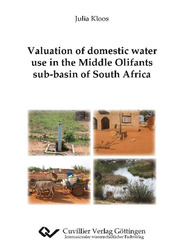| Departments | |
|---|---|
| Book Series (96) |
1378
|
| Nachhaltigkeit |
3
|
| Gesundheitswesen |
1
|
| Humanities |
2363
|
| Natural Sciences |
5406
|
| Mathematics | 229 |
| Informatics | 319 |
| Physics | 980 |
| Chemistry | 1363 |
| Geosciences | 131 |
| Human medicine | 243 |
| Stomatology | 10 |
| Veterinary medicine | 108 |
| Pharmacy | 147 |
| Biology | 835 |
| Biochemistry, molecular biology, gene technology | 121 |
| Biophysics | 25 |
| Domestic and nutritional science | 45 |
| Agricultural science | 1004 |
| Forest science | 201 |
| Horticultural science | 20 |
| Environmental research, ecology and landscape conservation | 148 |
| Engineering |
1791
|
| Common |
98
|
|
Leitlinien Unfallchirurgie
5. Auflage bestellen |
|
Advanced Search
Valuation of domestic water use in the Middle Olifants sub-basin of South Africa (English shop)
Julia Kloos (Author)Preview
Table of Contents, Datei (74 KB)
Extract, Datei (120 KB)
In South Africa, water is a relative scarce resource that is distributed unevenly geographically and saisonally as well as socially. The Middle Olifants sub-basin of South Africa was chosen as study area, because it is characterized as a very water scarce region -it is counted as the third most stressed basin in South Africa -with a poor and predominantly rural population. Households in former-homeland areas are still disadvantaged and lack access to su?cient and reliable water services. Current water use in the basin leads to overuse of the resource at the expense of domestic and environmental water needs.
For an e?ective water management that is able to address the South African policy objectives of e?ciency in water use, equity in access and bene?ts as well as long-term sustainability, economic valuation of the di?erent water uses is required. In order to assist policy-makers in reaching these goals, this study contributes to the existing knowledge by providing information on the economic value of water in domestic uses. For this purpose, two separate choice experiments were designed to detect preferences and ‘Willingness to pay’ for di?erent water service levels and water sources.
Results of a household survey of 475 households provide a clear picture of the di?erent water sources and service levels received by households in the Middle Olifants. Sampled households using basic water sources such as Public taps, Yard connections or Boreholes consume on aver¬age only 18.68 liter per person per day, while households with private taps inside their houses consume 78 liter per person per day. To analyze preferences for water services at the house¬hold level and to detect households’ ‘Willingness to pay’ for improved service levels, choice experiments were carried out in four villages and one town. Data analysis indicates the pres¬ence of preference heterogeneity and, hence, a latent class model was applied, readily dividing households into homogeneous groups according to their preferences. Several distinct classes of households could be found di?ering signi?cantly in terms of socio-economic characteristics, particularly household income, current water consumption and service levels as well as atti¬tudes towards pricing of water and satisfaction with current water service levels. ‘Willingness to pay’-estimates of single water service characteristics of all groups indicate that households are willing to pay higher prices for a better and more reliable water provision. But the amount of money households are willing to spend di?ers among groups. Price sensitivity was found to be strongly linked to income. With increasing income, price sensitivity of households decreases. This information is helpful for policy-makers to enable the design of water services in the Mid¬dle Olifants according to preferences of local households. The increase in ‘Willingness to pay’ with increasing income shows that subsidies either as income subsidies or lower water tari?s may be useful tools to allow low-income households to pay water bills.
| ISBN-13 (Printausgabe) | 3869557702 |
| ISBN-13 (Hard Copy) | 9783869557700 |
| ISBN-13 (eBook) | 9783736937703 |
| Final Book Format | A5 |
| Language | English |
| Page Number | 176 |
| Lamination of Cover | glossy |
| Edition | 1 |
| Volume | 0 |
| Publication Place | Göttingen |
| Place of Dissertation | Universität Bonn |
| Publication Date | 2011-06-01 |
| General Categorization | Dissertation |
| Departments |
Agricultural science
|








